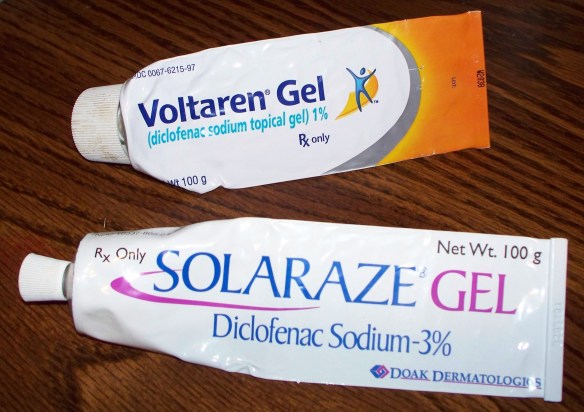 Diclofenac is a Non-Steroidal Anti-Inflamatory Drug (NSAID). There are many different NSAIDs, some available by prescription, and some easily obtained over-the-counter (ie ibuprofen/advil, naproxen/aleve, etc.)
Diclofenac is a Non-Steroidal Anti-Inflamatory Drug (NSAID). There are many different NSAIDs, some available by prescription, and some easily obtained over-the-counter (ie ibuprofen/advil, naproxen/aleve, etc.)
Diclofenac can be taken orally, but it also comes in a topical gel. I use this in addition to my oral NSAID. The advantage of the gel is that it bypasses the stomach.
There are two different names for diclofenac gel: Voltaren and Solaraze. Voltaren is often prescribed for OA. My first rheumy prescribed Solaraze instead of voltaren. Since the prescription was accompanied by a $35 rebate coupon, I assume that this is a direct result of pharmacy reps. RA is an off-label use for solaraze.
What’s the difference?
- Solaraze is used twice a day. Voltaren is used four times a day. That makes the solaraze much more convenient to use. I can apply solaraze gel right after my morning shower, and again before I go to bed. It’s pretty difficult to make time for four applications of the voltaren on a daily basis.
- Solaraze is 3%; Voltaren is 1%. I assume that the strength difference reflects the difference in frequency of use.
- Solaraze is clear and cannot be felt after it has soaked in. Voltaren is a cloudy-white color; it feels slimy.
- Solaraze is unscented. Voltaren stinks.
- The voltaren reeks. Not to belabor the point, but the the odor is so awful that it really deserves to be listed twice. When I was using it, I’d sit upstairs to put it on. People downstairs would yell up, “Are you using that awful stuff again? We can smell it clear down here!”
My co-pay on both strengths of diclofenac gel is in the top tier (read “most expensive”); I pay the same amount no matter which one is used. Cash price, though, is significantly different:
- Voltaren: $34
- Solaraze: $415
____
NSAIDs (not steroids) are contrasted with prednisone, which is a steroid

Since NSAIDs do nothing to stop or slow the progression of RA, I would personally rather use a topical such as Icy Hot or something similar rather than an nsaid cream on top of an oral NSAID. Also, I know every one is different, especially when it comes to nsaids and which one works for them, but just want to mention that diclofenac does have some worse cardiovascular profile (stroke, heart attack) than some of the other nsaids. Wish they’d do a head to head study of ALL Nsaids.
Diclofenac is not my oral NSAID. I’ve been through a whole list of those. First rheumy gave me the choice between oral tramadol, lidoderm (a lidocaine patch), or the topical NSAID. The topical gel helps, so I’d rather use it than one of the other options. Every now and then I stop using it, but quickly find that it really was helping 🙂
I agree; a head-to-head study of all the NSAIDs would be interesting.
same active ingredient, but such a big price difference.
Solaraze is for topical skin use for solar keratoses. It has propylene glycol added to improve pooling of the active agent in the skin (that’s the theory anyway). They are trying to minimize the systemic absorption with solaraze. In theory it wouldn’t work as well for rheumatoid arthritis.
May 2015: recent price @ Costco 1000.00 for large tube of Solaraze.
Allergic to all NSAIDs plus prostaglandin blockers.,E&F. Need something to counteract pseudo gout pain. So far I use mostly at night.
Solaraze works wonders for my OA, not RA. It has 3 times more diclofenac and i can definitely feel the difference after each application. I still use it 4 times daily as my MD said it wont hurt. It is genereic so my copay is only 10$. I know its more expensive on my insurance but hey thats what those money hungry bastards are for